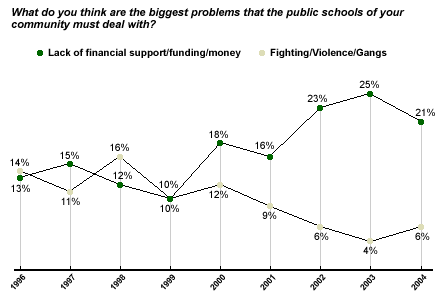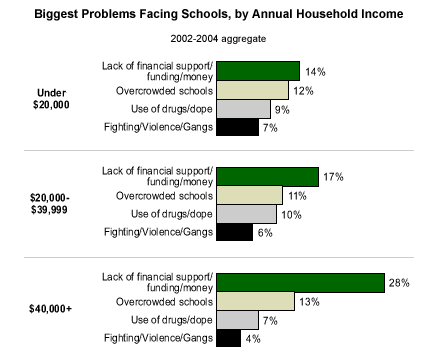If, as the song goes, "money makes the world go around," then a significant number of Americans must think their local schools are virtually standing still. One in five Americans (21%) say that lack of financial support is the biggest problem facing their local schools today, according to the 2004 Phi Delta Kappa/Gallup Poll of the Public's Attitudes Toward the Public Schools*.
But money is not the only problem. Americans mentioned overcrowded schools and lack of discipline among students as the No. 1 problem -- each cited by 10% of Americans -- as well as such perennial concerns as drug use (7%) and violence (6%).

Every year, the PDK/Gallup survey asks Americans about the biggest problems the public schools in their own communities are dealing with. Although the percentage citing lack of funding has dropped slightly since last year, it remains above 20% for the third year in a row, after hovering between 10% and 15% during the late 1990s.

Some of the increase in concern about school funding may be due to the gradual diminishing of concern about fighting/violence/gangs since the late 1990s, when the violent crime rate was higher in many U.S. cities and there was a spate of deadly school shootings.
In part, the public's elevated concern about school funding may also be a reaction to budget crises that have forced state legislatures to make cuts in almost every area over the last few years, including education. A recent report by Education Trust, an independent nonprofit organization, found that funding disparities between poor and wealthy school districts have widened since 2000, after narrowing in the boom period of the late 1990s. According to the report, in 2002, high-poverty districts received $1,368 less per student from state and local governments than did more affluent districts. That gap is up from $1,287 in 2001 and $1,208 in 1997.
If state budget crunches are harder on schools in low-income areas, it seems logical that less affluent Americans would be more likely to see their local schools struggling with lack of funding. However, that is not the case -- aggregated PDK/Gallup data from the past three years reveal that respondents with household incomes of $40,000 and more are actually more likely than those earning less than $40,000 to name lack of financial support as one of the biggest problems facing their schools. Among lower-income people, funding ranks along with overcrowding and the lack of discipline as the major problems. In the higher-income categories, there is a larger gap between funding and other problems.

That's not to say, however, that students in low-income areas aren't disproportionately affected by insufficient school funding. The Education Trust report contends that schools in poverty-stricken areas need more resources to meet the same standards, so even if all schools are squeezed equally, poorer students are more likely to feel the effects.
In some cases, education advocates unable to make headway with state legislators are taking their appeals directly to the public. On Nov. 2, residents of Nevada, Oklahoma, and Washington will decide on measures that could dramatically raise school funding levels. However, in other states, such as Maine and Missouri, voters are considering measures that would limit municipalities' ability to levy property taxes, and therefore reduce the funds available for schools.
Bottom Line
The issue of education funding has naturally been part of this year's acrid political dialogue. John Kerry has accused President George W. Bush of underfunding the current administration's No Child Left Behind law, while Bush has pointed to the 49% increase in federal funding for education during his presidency.
But PDK/Gallup data suggest that the public was growing increasingly concerned about education funding long before the political finger-pointing began. Challenging economic times have forced Americans to consider their priorities -- and as many state and local governments are discovering, education is a priority few are willing to relinquish.
*The findings of the survey are based on telephone interviews with a random sample of 1,003 U.S. adults, aged 18 and older, conducted from May 28 to June 18, 2004. For results based on this sample, one can say with 95% confidence that the maximum error attributable to sampling and other random effects is ±3 percentage points.